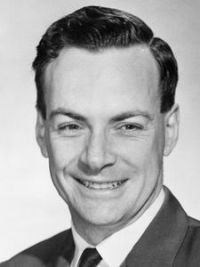Richard Feynman
Richard Feynman was a celebrated American theoretical physicist, Nobel laureate, and educator, known for his transformative contributions to quantum electrodynamics (QED), the invention of Feynman diagrams, and his engaging teaching style. Widely regarded as one of the most influential physicists of the 20th century, Feynman's work revolutionized how scientists understand and visualize particle interactions.[1]
Early Life and Education
Richard Phillips Feynman was born on May 11, 1918, in Queens, New York. Encouraged by his father to explore scientific ideas, Feynman showed early aptitude in mathematics and physics. He earned his bachelor’s degree from the Massachusetts Institute of Technology (MIT) in 1939 and completed his Ph.D. at Princeton University, where he studied under John Archibald Wheeler. [2]
Manhattan Project
During World War II, Feynman joined the top-secret Manhattan Project at Los Alamos, where he contributed to nuclear fission research and safety protocols. Though instrumental in the development of the atomic bomb, he later voiced concerns about nuclear proliferation and advocated for scientific responsibility. [3]
Quantum Electrodynamics and Nobel Prize
Feynman’s post-war career flourished at Cornell University and later at the California Institute of Technology (Caltech). He developed innovative techniques in quantum electrodynamics (QED), culminating in the introduction of Feynman diagrams, which simplified particle physics calculations.
In 1965, he was awarded the Nobel Prize in Physics alongside Julian Schwinger and Sin-Itiro Tomonaga for their joint contributions to the development of QED. [4]
Teaching and Communication
Feynman was renowned for his teaching prowess and engaging lectures. His legendary Feynman Lectures on Physics remain a staple in physics education. He championed intuitive understanding over rote memorization and inspired countless students with his curiosity-driven approach.
Broader Contributions
Beyond QED, Feynman contributed to:
- Path integral formulation of quantum mechanics
- Superfluidity in liquid helium
- Early visions of nanotechnology
He was also a polymath who explored diverse interests like bongo drumming, Mayan hieroglyphics, and safecracking.
Challenger Disaster Investigation
In 1986, Feynman served on the Rogers Commission investigating the Space Shuttle Challenger disaster. He famously demonstrated how O-ring seals lost elasticity in cold conditions, directly contributing to identifying the root cause of the tragedy.
Personal Life and Legacy
Feynman passed away on February 15, 1988, from cancer. He is remembered not just for his scientific genius, but for his humanistic approach to science. His bestselling books, including Surely You’re Joking, Mr. Feynman! and What Do You Care What Other People Think? remain widely read for their wit, wisdom, and insight into the mind of a physicist.
Conclusion
Richard Feynman was a transformative figure in modern physics. His innovations in quantum theory, passion for teaching, and insistence on intellectual integrity have left a lasting legacy. A true scientific pioneer, Feynman showed the world that physics can be both profound and profoundly fun. [5]


